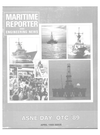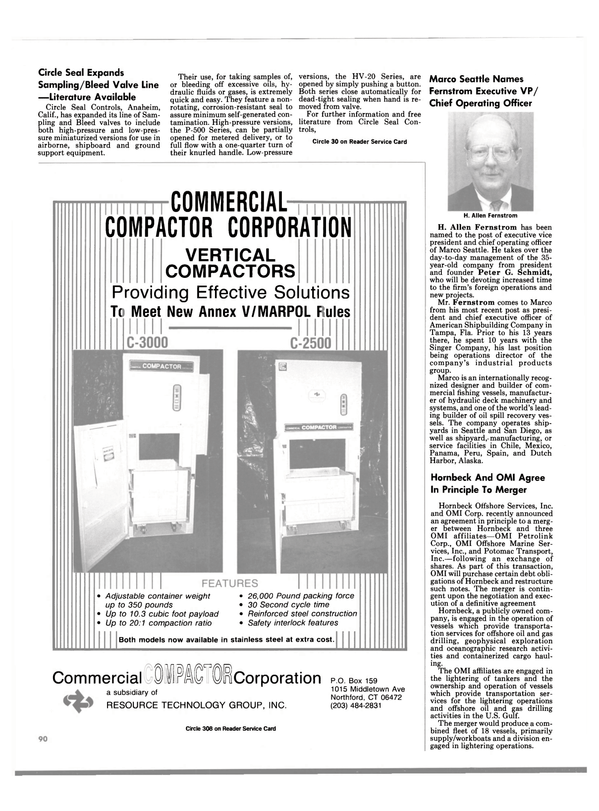
Raytheon's S N A - 9 1 Integrated Bridge System Is Said To M a k e Significant Contributions To Fuel Savings
Raytheon Marine is offering a free, four-color brochure fully detailing its new cost-saving Integrated Bridge System, SNA-91. The fold-out publication features color photos, dimensional drawings and a detailed block diagram describing the system and its operation. In addition, the brochure provides information on functional specifications such as position fixing, navigation planning, route tracking, ARPA and data display.
According to Raytheon Marine, its innovative SNA-91 Bridge Integration System makes significant contributions to fuel savings for ships of this size. The company claims this system often saves as much as 2 percent of the fuel costs, or about $5,000 a month. It does this with the use of its own built-in adaptive steering system which minimizes unnecessary rudder movements.
It also interfaces with performance sensors to monitor engine, hull, weather, and navigation data.
The SNA-91 consists of a Navigation Control Unit with a multicolor 20-inch Raster Scan CRT; a Computer Planning Terminal, including floppy disks for electronic charts, data and programs; plus a Chart Digitizer; and Printer.
Designed to be easy to use, the SNA-91 Bridge Integration System presents a broad range of ship management information on-screen. For example, three electronic "pages" of engine data include: propeller rpm, propeller pitch angle, shaft horsepower, torque, turbocharger rpm, engine start air pressure, temperature and load, and fuel oil consumption.
The computerized integration system also displays hull pitch and roll data, draft and trim, and propeller slip ratio.
The SNA-91 interfaces with the ship's navigation systems, including gyro, log, SatNav, GPS, Loran, and radar. When interfaced with Raytheon's Pathfinder®/ARPA (Automatic Radar Plotting Aid) the SNA- 91 displays ARPA-track radar targets, along with electronic charts, navaids and other data. The SNA- 91 and ARPA transmit information back and forth, so that the ARPA can also display buoys, coastlines, etc., enabling the operator to see electronic chart data in relation to radar images. By exchanging data, the two systems provide "map match" checks resulting in the highest level of accuracy possible.
Raytheon's Pathfinder/ST ARPA, with ranges from 1/4 to 96 nm, automatically monitors up to 40 targets simultaneously, and displays vectors and data for the 20 most critical targets, on a very sharp, ultra bright, 34-cm CRT. Among route planning features available is a Trial Maneuver mode, which allows allows the operator to enter possible changes in course and speed to determine best course of action.
With the introduction of the M/V President Adams into trans-Pacific service last fall, a total of five new ClO-class ships joined the American President Lines fleet in 1988. They were designed to meet the needs of APL's Pacific Basic customers,- using the most advanced technologies available, including a "wide body," non-Panamax hull, and a new, computerized Integrated Bridge System.
These ClO-class ships' navigation consoles are designed in " T " formations with an SNA-91 Bridge Integration System and Raytheon Pathfinder/ ST ARPA on each arm, and engine and steering controls in the center. The integrated dual system helps to make it easy to carry out navigation and other ship performance functions from one location.
Built in Germany by Howaldswerke- Deutsche Werft (M/V's President Kennedy/Truman/Jackson) and Bremer Vulkan (M/V's President Polk/Adams), the ClOs incorporate many of Germany's "Ship-of-the-Future" ideas into their design, as part of APL's efforts to reduce costs on a per-containermile basis.
For further information on the Integrated Bridge System, Circle 3 on Reader Service Card
Read Raytheon's S N A - 9 1 Integrated Bridge System Is Said To M a k e Significant Contributions To Fuel Savings in Pdf, Flash or Html5 edition of April 1989 Maritime Reporter
Other stories from April 1989 issue
Content
- Balehi Marine Converts Crewboat Into Party Charter Yacht 'Celebrity' page: 4
- New MIG Welding Power Sources Use Single Phase, AC Power page: 5
- Combustion Engineering, Alsthom Plan Joint Boiler Manufacturing Business page: 5
- N e w High-Efficiency Incinerators Introduced By H a m w o r t h y Offer Solution To On-Board Waste page: 6
- Fincantieri Delivers Rail/Car/Passenger Ferry To Italian State Railways page: 6
- Harris Introduces New Remote Control Unit For Its RF-3200 SSB Radio page: 8
- SNAME Opens Membership Doors page: 10
- Blount M a r i n e To Build Ultramodern Dinner Boat page: 11
- Lykes Bros. Acquires Argonaut Line, Parent Company Of Farrell page: 11
- Fjellstrand Wins Order For Two High-Speed Passenger Catamarans page: 12
- Peterson Builders A w a r d ed $ 1 8 5 - M i l l i o n N a v y Contract To Build Three More MCMs page: 12
- Ocean Specialty To Charter U.S.-Flag Product Carriers From OMI, Hvide Shipping page: 14
- Acurex Sea Trials Meter Provides User With Complete Versatility page: 14
- Navy's Newest T-AGOS Christened At Tacoma Boat page: 15
- Literature Available On New Marine Products Made From 'Orkot' page: 15
- USCG Ammends Illegal Drug Policy For Commercial Fishing page: 16
- Comsat Names Taricco Western Region Manager, Maritime Industries Sales page: 16
- Bird-Johnson Wins Contract To Supply T-AO Class Propellers page: 16
- Dr. Daniel True Appointed Senior Research Civil Engineer At NCEL page: 18
- TTS Receives $5.5-Million Contract In Shipyard Modernization page: 18
- Apelco's Color Fishfinder/ Plotter Is Powerhouse In A Small Package page: 18
- Allied Shipbuilders Delivers Caterpillar-Powered Tug page: 20
- JJH Awarded Navy Pact For Design Services For Lead Minehunter Ship page: 21
- New Brochure Outlines Worldwide Capabilities Of Drew Ameroid Marine page: 21
- Furuno Introduces N e w Line Of Medium-Size Radars And N ew V i d e o Sounder W i t h Etched CRT page: 22
- KaMeWa Expands Product Range Through Licensing Agreement page: 22
- OTC '89 SPECIAL PREVIEW page: 25
- Soundcoat Introduces Quilted Barrier Absorber page: 40
- $2.2-Million Conversion Contract Completed For Indian Firm By Keppel page: 42
- Banck Named President, TANO Marine Systems page: 42
- Red Fox Offers Free 20-Page Brochure On Marine Sanitation Systems page: 43
- Meyer Werft Books Order To Convert Car Carrier Into Livestock Carrier page: 46
- Bender Inc. Offers Literature On Electrical Safety Monitoring Systems page: 46
- Hvide Shipping Requests Bids From 14 U.S. Shipyards For Tanker Reconstruction page: 48
- Furuno Introduces New 14-Inch Weatherfax page: 49
- Free StartMaster Literature Describes User Benefits Of Air Starting Systems page: 49
- Detroit Diesel Introduces Three N e w High-Speed Engines page: 50
- 'Naval Engineering Into The Next Century' page: 54
- INTERCON To Build Cranes For U.S. Navy's T-ACS Crane Ship Program page: 62
- Free Pamphlet Details How To Buy DoD Surplus Personal Property page: 64
- JJH Names John Dachos To Management Staff Of Cherry Hill, N.J., Office page: 64
- Flagg Offers Catalog On Complete Line Of Fittings And Flanges page: 66
- Jeffboat To Reopen Shipyard; Will Resume Construction Of Barges And Towboats page: 68
- Furuno Introduces N e w 6-Inch And 8-Inch Dual-Frequency Color V i d e o Sounders page: 69
- Atlantic Marine To Lease ADDSCO Industries Ship Repair Yard In Mobile, Ala. page: 70
- New Cold Welding Repair Material Offered page: 70
- Rados International Designing Cummins-Powered Fireboat For City Of Los Angeles page: 72
- Seacoast Electric Offers Marine Cable And Service Brochures page: 73
- SeaArk Marine Delivers First Five Patrol Boats Of Ten-Vessel Contract page: 74
- Gems Flow Switch Available With Infinite Adjustability To Protect Expensive Equipment page: 74
- Evergreen's $1.2-Billion Order For Containerships May Go To Japanese page: 75
- International Compactor Offers High-Performance Trash Compactors page: 76
- Folk Disc Couplings Feature Fast Assembly, High Reliability page: 77
- Magnavox Introduces Latest In Series Of GPS Data Outputs page: 77
- OSHA Gives Avondale Its Highest Safety Award page: 78
- Aeroquip Offers New Cargo Control Products Bulletin page: 78
- Tradex Marine Equipment Offers Two New Products page: 78
- Trimble Introduces GPS With Integrated Loran And Electronic Charts On CDs page: 78
- New Worldscale Takes Effect—Intertanko Offers Informative Booklet page: 79
- Drydocking At Todd Los Angeles Sets Record For Heaviest Lift On Yard's Syncrolift System page: 80
- Prelube/Postlube Systems Offered By Kim Hotstart page: 80
- BFGoodrich Rivnut Develops Innovative New Floating Fastener page: 81
- GE's M a r i n e Gas Turbine Family Expanding To Satisfy The Markets page: 82
- Dynabrade's Air-Powered Abrasive Belt Machine Converts To Other Tools page: 84
- MARCO-Seattle To Build Two Alaskan Longliners page: 84
- Sperry Marine Rascar Gains Acceptance With Naval Communities page: 85
- N e w W o r l d w i d e Distributor N e t w o rk For EMD Power Products page: 86
- ABB Turbo Systems Formed —Literature Available page: 87
- Raytheon's S N A - 9 1 Integrated Bridge System Is Said To M a k e Significant Contributions To Fuel Savings page: 88
- Raytheon's N e w Professional Loran Is Highly Accurate And Also Exceptionally Easy To Use page: 88
- Hagglunds Marine Reports Brisk Sales For Cranes page: 89
- SPD In Joint Venture With Daeyang Electric page: 89
- Circle Seal Expands Sampling/Bleed Valve Line page: 90
- Marco Seattle Names Fernstrom Executive VP/ Chief Operating Officer page: 90
- Hornbeck And OMI Agree In Principle To Merger page: 90
- Falk Offers Revised Speed Reducer Bulletin page: 91
- USCG Proposes New Regulations For Small Passenger Vessels page: 93
- Resource Technology Expands M a r i n e Trash C o m p a c t o r Line page: 93
- Ingram Barge Company Acquires Additional Barges And Towboats page: 94
- Conrad Industries Delivers Floating Drydock For Use At New Missouri Repair Yard page: 98
- Aiken-Murray Offers Brochure On Chemical And Engineering Services page: 101


